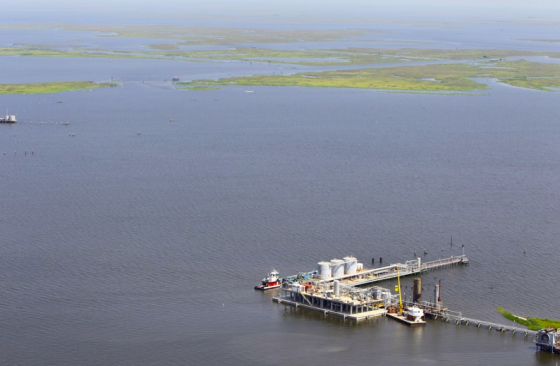Perspectives on the Gulf: Dr. Michael J. Blum
The one-year anniversary of the Deepwater Horizon well blowout is fast approaching, with sparring narratives being presented on Gulf recovery since the event. In one corner, BP is offering defensive arguments that the extent of economic and ecological damage is probably a fraction of initial estimates, and similarly, that long term injuries are likely to have a shorter half life than first expected. In the opposing corner sit a tag-team of federal and state trustee agencies, public interest groups and private citizens, pushing back with reports of lost income, depressed economies, dead baby dolphins washing ashore, and the persistence of oil in near-shore sediments. Dancing around somewhere in the middle are research scientists, attempting to referee the exchange of information being presented by the embattled parties.
By many accounts, this fight should have been over by now. From the beginning, the odds were not favoring BP and its partners. Lives were lost. An estimated 205 million gallons of oil were released into the Gulf. Detailed, day by day accounts documented oil spreading across the northern Gulf of Mexico, grounding onto hundreds of miles of coastline stretching from Florida to Louisiana. Oil penetrated far into the fragile wetlands of the Mississippi River delta, putting some of the most productive fisheries in North America at risk of collapse. And that’s what we could readily observe on the ocean’s surface and shorelines. Unmanned vehicles exploring deep waters captured disconcerting evidence of hydrocarbon plumes and thick accumulations in sediments extending for miles away from the blown well head. Perhaps more troubling, however, were the questions that this raised about the ultimate fate and effects of oil in the open ocean and deep benthos.
BP was quiescent during the response phase of the blowout- emphasizing that it would be a responsible party in stopping the flow of oil and providing compensation for loss of livelihood. Under intense scrutiny, BP also provided block grants to Gulf coast universities for researchers to fast-track studies of oil in the environment (the National Science Foundation also provided support for similarly minded studies). The availability of funding facilitated a more rapid pace of discovery compared to prior releases, such as the Exxon Valdez oil spill, but there were growing concerns that the studies being carried out were not necessarily going to provide information that would help prevent future blowouts, improve methods for future response and recovery efforts, or provide a clearer understanding of effects arising from oil being released into the Gulf.
These concerns intensified as the legally mandated process of detailing injury began to unfold after oil stopped flowing into the Gulf. The Natural Resource Damage Assessment (or NRDA for short) is a framework for documenting ecological losses that result from oiling, and the steps that must be taken to restore these losses. It is a slow and methodical process that is intended to provide a plan and price tag for restitution. It requires careful and detailed documentation of damage by trustee agencies (or contractors thereof) that will be presented in court as evidence of liability. As the defendant, BP began pushing back by undertaking parallel studies to counter the evidence presented by the trustee agencies. With both sets of studies well underway, research scientists based in the Gulf and elsewhere (many of whom cut their teeth working on the Exxon Valdez oil spill) began openly questioning whether the NRDA process is a suitable tool for determining damages and restitution from deepwater well blowouts.
The NRDA process, as it is currently structured, reflects a cumulative understanding of past events. Most, if not all, of these events are surface spills (like the Exxon Valdez spill) or well blowouts in shallow water (like the 1979-1980 Ixtoc I blow out, and the 1969 Santa Barbara blow out). Consequently, assessment and monitoring is directed towards the ocean’s surface (often referred to as its “skin”) and shorelines (often referred to as its “sides”). This approach is effective for events like the Exxon Valdez spill, which resulted in oil flowing into surface waters and grounding onto the ecologically rich shorelines of Prince William Sound. Activities directed towards the ocean’s skin and sides, of course, cannot document effects in other habitats that may be affected by a deepwater well blowout, including the pelagic water column (subsurface to deep water) and soft-bottom and hard-bottom benthos. Although often thought of as “out of sight, out of mind”, these areas are frequented by at-risk species including sperm whales that feed at great depths, and serve as spawning grounds for economically important fisheries like blue-fin tuna.
The sparring between BP and trustees over damages, restitution and restoration has been proceeding in plain site over the past year, but it will undoubtedly intensify as the national and international media swing their cameras back to the Gulf in preparation for the first year anniversary of the Deepwater Horizon blow out. The competing narratives that will be presented will serve to further define public understanding and perception of the event. The trustees and their partners will likely portray the Gulf as having been damaged, whereas BP and its partners will likely portray the Gulf as having recovered. Research scientists (especially those not involved with the NRDA process) will undoubtedly find it challenging to referee this discourse, but it is imperative that substantive efforts are made to remind the public that our understanding of the Deepwater Horizon blowout is incomplete, and possibly based on a fundamentally flawed conceptual framework.
There is no question that the Deepwater Horizon blowout ranks as an environmental disaster of global proportions. In an era of energy production shifting away from coastlines, it has redefined our understanding of risks associated with deep water wells. It has enhanced our awareness of the intricate complexity of communities whose livelihoods rely as much on the energy sector as on fisheries that are at risk from well blowouts. It has refocused our attention on the Mississippi River Delta, which is a resource of national importance that is rapidly being lost. And depending on the discourse that emerges over the next few months, it is possible that it will also redefine how we will value knowledge and understanding during and following future disasters of similar magnitude.
Michael Blum received his B.A. in Integrative Biology from the University of California, Berkeley and his Ph.D. in Zoology from Duke University. He completed a postdoctoral fellowship with the US EPA National Exposure Research Laboratory. He is currently the Arnold Early Career Professor in Earth and Ecological Science at Tulane University. His research interests include ecological and evolutionary responses of wetland plants to environmental stressors, land use effects on water quality, and water availability under future climate conditions.
























NO COMMENT
Leave a comment